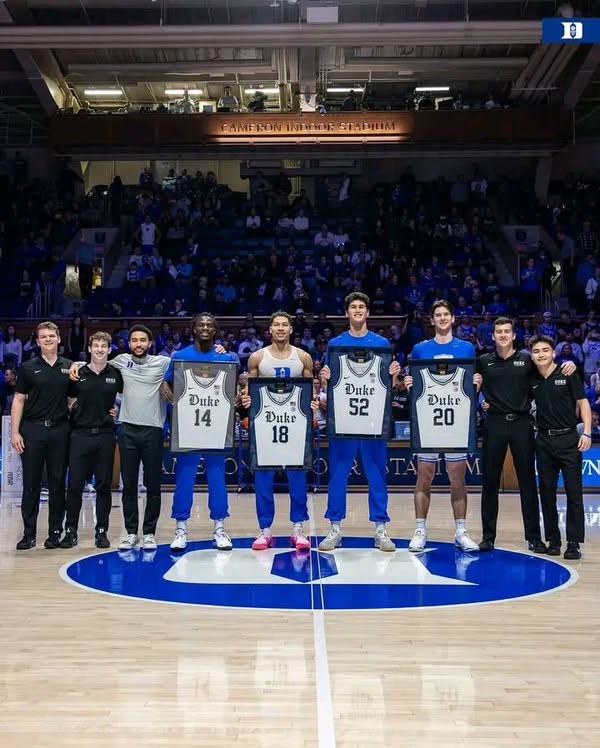Duke Basketball’s Post-Portal Power Shift: How a Top Recruiting Class is Transforming the Blue Devils for 2025–2026 Season
The Duke Blue Devils, a storied program synonymous with college basketball excellence, are undergoing a seismic transformation as they prepare for the 2025–2026 season. With one of the highest-ranked recruiting classes in the nation, Duke is embracing a new era defined by a significant power shift—one that reflects the evolving landscape of college basketball in the post-transfer portal era. This period, marked by the fluid movement of players between programs, has reshaped team dynamics across the country, and Duke’s recent recruiting success highlights how elite programs are adapting to maintain dominance. Understanding what has just taken place at Duke requires examining the strategic decisions behind this overhaul, the impact of the transfer portal on roster building, and how this fresh infusion of talent positions the Blue Devils as a powerhouse in the coming season.
Historically, Duke has been known for its ability to recruit and develop top-tier talent, often securing elite high school prospects through legendary coaching and a tradition of success. The 2025 recruiting cycle is no exception; it features a collection of highly touted players that promises to reinvigorate the team’s roster. However, the significance of this class goes beyond simply stacking talent. This recruiting haul represents a conscious recalibration by Duke’s coaching staff in response to the challenges and opportunities created by the transfer portal. The portal, which allows players to transfer schools with fewer restrictions, has fundamentally changed how college programs build and maintain their rosters. Rather than relying solely on long-term recruiting pipelines and player development within their own systems, programs now must compete for transfers who can offer immediate impact and veteran experience.
Duke’s response to this shift is twofold: an aggressive approach to both recruiting high school prospects and courting impactful transfers. The recent class merges the promise of youth with the readiness of experienced players, creating a roster that balances potential with immediate competitiveness. This dual strategy is crucial because the transfer portal has made the traditional college basketball offseason a whirlwind of change, where teams must continuously adapt to players leaving or arriving at a moment’s notice. Duke’s coaching staff, led by their visionary leader, has embraced this reality by positioning the program as a destination not only for rising stars but also for established college players seeking a fresh start or a more prominent role.
The composition of Duke’s incoming class reveals this strategic balance. On one hand, several of the signees are among the highest-ranked high school athletes in the country, bringing exceptional athleticism, skill, and basketball IQ. These young players are expected to form the foundation of Duke’s future, developing under the guidance of the coaching staff and gradually taking on leadership roles. On the other hand, Duke has also been active in acquiring transfers who have already proven themselves at the collegiate level. These players provide a degree of stability and experience that complements the raw talent of the freshmen, helping to shorten the adjustment period that typically comes with integrating a large group of newcomers.
This combination is vital because it addresses the competitive realities of college basketball today. The accelerated timelines for player development and the pressure to win immediately demand rosters capable of producing results from day one. Freshmen, no matter how talented, often require time to adapt to the college game’s physicality and speed. Transfers, meanwhile, bring with them familiarity with college competition, often translating into more consistent production. By blending these two sources of talent, Duke aims to build a team that is both dynamic and resilient—one that can contend at the highest level while grooming the next generation of stars.
The broader implication of Duke’s approach is a reflection of how college basketball programs are increasingly viewing roster construction through a multi-dimensional lens. No longer can teams rely solely on recruiting rankings or long-term player development; success hinges on flexibility, adaptability, and the ability to capitalize on the fluid player movement enabled by the transfer portal. Programs like Duke, with deep resources and a compelling brand, are well-positioned to leverage this new environment to their advantage. They can attract top recruits drawn to the legacy and development opportunities, while simultaneously appealing to transfers seeking a winning culture and exposure on a national stage.
Another factor contributing to the power shift at Duke is the changing coaching landscape. The current coaching staff has demonstrated an ability to recruit effectively, develop players, and manage the complexities of a roster that includes both high school signees and transfers. This expertise is crucial in orchestrating a seamless integration of new players and maintaining team chemistry. The coaches’ vision and adaptability have allowed Duke to thrive in a landscape that demands constant evolution. Their strategy is not simply to reload with talent each year but to build a cohesive unit capable of sustained success.
This commitment to excellence and adaptability has immediate and long-term benefits. In the short term, the infusion of top-tier talent and experienced transfers positions Duke as a contender for conference titles and deep runs in the NCAA tournament. The blend of youth and experience can create a dynamic playing style that combines athleticism, skill, and tactical maturity. In the long term, this approach helps sustain Duke’s reputation as a premier destination for elite basketball talent. Success breeds success, and as Duke continues to excel in this new era, it will attract more high-profile recruits and transfers, perpetuating a virtuous cycle of excellence.
The timing of this overhaul is particularly significant. As college basketball moves toward greater parity and unpredictability, programs that can navigate the transfer portal effectively and combine it with strong recruiting will gain a competitive edge. The landscape is shifting away from a model where a handful of programs dominate by simply signing the best freshmen. Instead, versatility in roster management, adaptability to player movement, and strategic integration of transfers are becoming key drivers of success. Duke’s recent recruiting class and transfer acquisitions embody this paradigm shift, signaling the program’s readiness to thrive amid these changes.
Moreover, this shift also reflects broader changes in the college sports ecosystem. NIL (Name, Image, Likeness) deals, evolving NCAA regulations, and the increasing professionalism of college basketball have all contributed to a landscape where players have more control over their careers. This empowerment makes the transfer portal a critical tool for athletes seeking the best fit for their development and professional aspirations. Programs that understand and embrace this reality can position themselves as attractive destinations, offering not only basketball excellence but also the support and opportunities players desire.
Duke’s embrace of this new environment is a testament to the program’s resilience and forward-thinking leadership. It underscores their commitment to maintaining their elite status by evolving with the times rather than resisting change. This post-portal power shift is not merely about signing the best players; it’s about building a program capable of adapting and thriving in a highly dynamic environment. The Blue Devils’ 2025–2026 roster, forged through a blend of premier recruiting and strategic transfers, is a clear manifestation of this philosophy.
As the new season approaches, the basketball world will be watching closely to see how this transformed Duke team performs. With expectations sky-high, the players and coaches alike understand the weight of tradition and the promise of a new era. The post-portal power shift has given Duke a renewed identity—one that honors the program’s storied past while boldly embracing the future. If the current trajectory holds, Duke is poised not just to compete but to redefine the standards of excellence in college basketball for years to come.
In conclusion, what has just taken place at Duke is a fundamental recalibration of how the program builds and manages its roster in the post-transfer portal era. The infusion of one of the nation’s highest-ranked recruiting classes, combined with the savvy acquisition of key transfers, marks a strategic power shift designed to maintain and enhance Duke’s elite status. This approach reflects the evolving nature of college basketball, where adaptability, multi-faceted roster construction, and strategic recruitment are essential for sustained success. As Duke prepares for the 2025–2026 season, the Blue Devils exemplify how tradition and innovation can coexist, setting the stage for a new chapter in the program’s illustrious history.



